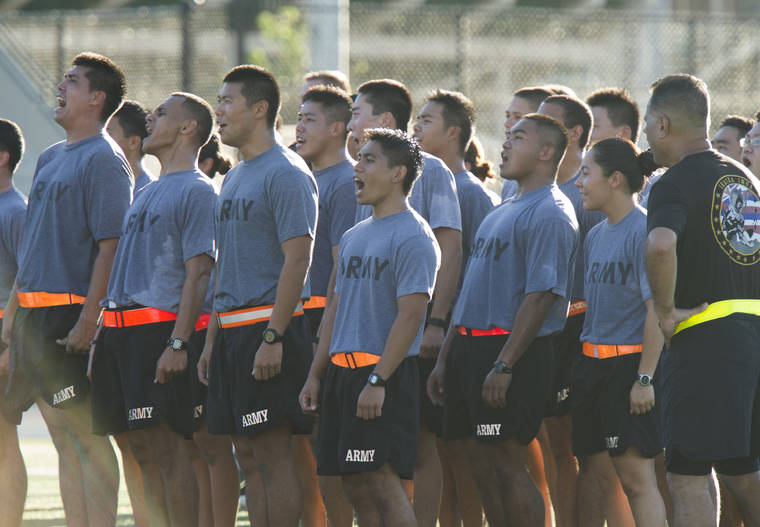University of Hawaii to get Navy ROTC program for first time

CRAIG T. KOJIMA / 2014
University of Hawaii’s Army ROTC members, after their morning workout, ran onto the field and gave the practicing University of Hawaii football team a short cheering session.
Navy Secretary Richard Spencer has approved the creation of the first-ever Naval Reserve Officer Training Corps program at the University of Hawaii at Manoa after many years of interest, U.S. Sens. Mazie Hirono and Brian Schatz announced today.
“The long-awaited establishment of a Naval ROTC program at UH Manoa underscores the Navy’s commitment to the Indo-Pacific region and represents a tangible step toward increasing the diversity of its officer corps,” Hirono said in a release.
The new ROTC program will give more Hawaii students a chance at earning scholarships and gaining an education, Schatz said.
“We are grateful and proud that the Navy has selected UH Manoa to host a new NROTC unit,” UH President David Lassner said. “We are already the home of exceptionally successful Army and Air Force ROTC units.”
ROTC programs train students to become commissioned officers. The establishment of a Navy ROTC unit will enable more Hawaii students to attend college affordably and serve their country, Lassner said.
Hirono and Schatz repeatedly encouraged the establishment of a Naval ROTC program at UH. Hirono in 2015 wrote letters to then-Secretary of the Navy Ray Mabus and then-Chief of Naval Operations Admiral John Richardson seeking the program.
Don't miss out on what's happening!
Stay in touch with breaking news, as it happens, conveniently in your email inbox. It's FREE!
Hirono, a Hawaii Democrat, is ranking member of the Senate Armed Services subcommittee on seapower. Schatz, also a Democrat, is ranking member of the Senate Appropriations subcommittee on military construction and veterans affairs.
In April, UH officials told the Honolulu Star-Advertiser that funding was included in the 2019 Navy budget — but hadn’t been released yet — for the start of the effort.
Vassilis Syrmos, vice president for research and innovation for the UH system, said at the time he was confident the Navy would approve the university’s application.
He said the addition would be a “great thing” for the university.
“It’s a great thing for the state, it’s a great thing for the (Defense Department) and the Navy,” he said.
The Army has had an ROTC program at UH since the 1920s. It was the only unit to be called to active duty and serve in World War II when its cadets were made a part of the Hawaii Territorial Guard after the Dec. 7, 1941, attack and assisted in guarding facilities around Oahu. An Air Force ROTC program followed.
Ron Cambra, assistant vice chancellor for undergraduate education, said in April that UH had “always been interested in Navy because of the obvious Pearl Harbor (connection) and the history in the islands. It’s just that Navy’s perception has been that they already had enough NROTC programs spread throughout the country.”
Despite that, about every three years, “almost like clockwork,” Cambra would get a call from a Navy lieutenant commander on island calling on behalf of a new admiral at U.S. Indo-Pacific Command or U.S. Pacific Fleet asking why UH didn’t have a Navy ROTC program.
“I had this conversation for nine to 12 years,” Cambra said, adding that there wasn’t much interest — then — when the question got back to Navy ROTC planners.
But “things have changed a little bit from where we were three to four years ago, obviously, and Hawaii is right in the middle of it,” Cambra said.
The Navy is growing, planning to add 5,000 or more sailors a year and trying to reach a 355-ship goal from 290 deployable battle force ships today.
The Army has received national recognition for its ROTC program several years running, and the Air Force effort has been rated “outstanding,” according to Cambra.
A Navy website said in the spring that its ROTC program was established in 1926 and that it was then available at more than 160 colleges and universities that either hosted Navy ROTC units or had crosstown enrollment agreements with a host university.
The Marine Corps entered the Navy ROTC program in 1932.
Cambra said the UH Army ROTC program has fewer than 200 cadets, while the Air Force program has about 75 to 80. He said the Navy program could have a number somewhere in between — but that would be up to the Navy.
The university would need to renovate some buildings for Navy use and envisions an upgraded ROTC campus if defense funding comes through.
The programs come with scholarship money, and the military pays for teachers, Cambra noted.



